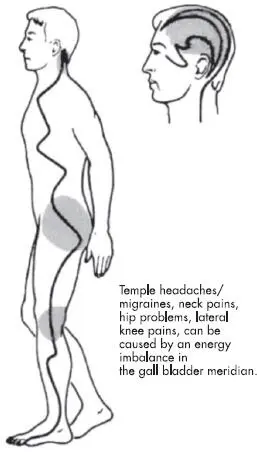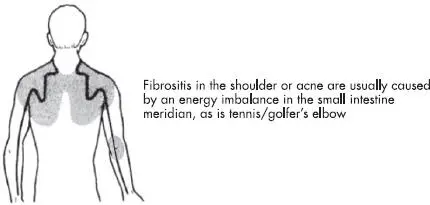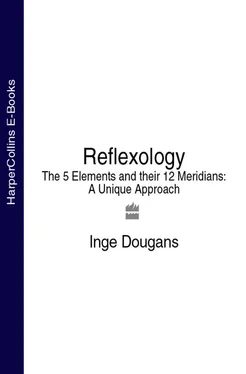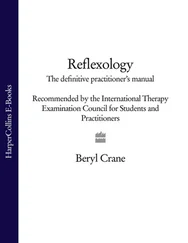The six main meridians – those that penetrate the major body organs – are represented in the feet, specifically in the toes. Thus stimulation of the feet helps clear congestions in the meridians. Meridian theory assumes that a disorder within a meridian generates derangement in the pathway and creates disharmony along that meridian, or that such derangement is a result of a disharmony of the meridian’s connecting organ. Knowledge of meridians can help reflexologists to understand the disease pathway more comprehensively. A basic knowledge of meridians can be of enormous benefit in pinpointing problem areas. If, for example, pain or irritation does not improve satisfactorily through treatment of the reflex area, one should observe the meridian, which traverses the part of the body in question, and treat the reflex area of the organ related to that particular meridian.
The meridians can be used simply and effectively for a better understanding of conditions. Take, for example, patients with arthritis in the little finger, tennis elbow, fibrositis in the shoulder blade, swollen lymph glands of the throat, facial nerve disorders or ear disorders such as tinnitus. One need simply look at the small intestine meridian – this starts in the little finger, ends just in front of the ear and passes the locations of all the above disorders. Could this mean that the small intestine disorder could aggravate or even cause these problems? Clinical results of balancing the meridians indicate this.
If a patient is suffering from pain in the right knee, question exactly where the pain is situated – on the front, back, medial or lateral section of the knee. If the pain is on the lateral side, it will fall into the gall bladder meridian. The gall bladder reflex should then be assessed, and will usually be found to be sensitive. Although the organ itself may not be diseased, the congestion on the meridian is causing pain and discomfort.
It is important to distinguish between ‘organ conditions’ and ‘energy conditions.’ An ‘organ condition’ is evident when an organ is not functioning properly. This could manifest as digestive or respiratory problems, hormonal disturbances and the like. Energy conditions – for instance, headaches, sciatica, facial nerve disorders and hip pains – are more difficult to define. These conditions are often found along a meridian pathway, and the related organ reflex will usually be sensitive. This does not necessarily indicate an organ disorder. Energy conditions are usually forerunners of more serious problems, and if they are not treated early on, they can eventually influence the related organ and result in a chronic problem. Pains in the fingers and toes often indicate which meridian is congested. For example, pains in the index finger refer to the large intestine meridian, while pains in the big toe could refer to either the liver or spleen/pancreas meridians.

Fig. 3a Energy congestions – gall bladder meridian

Fig. 3b Energy congestions – small intestine meridian
Конец ознакомительного фрагмента.
Текст предоставлен ООО «ЛитРес».
Прочитайте эту книгу целиком, купив полную легальную версию на ЛитРес.
Безопасно оплатить книгу можно банковской картой Visa, MasterCard, Maestro, со счета мобильного телефона, с платежного терминала, в салоне МТС или Связной, через PayPal, WebMoney, Яндекс.Деньги, QIWI Кошелек, бонусными картами или другим удобным Вам способом.














